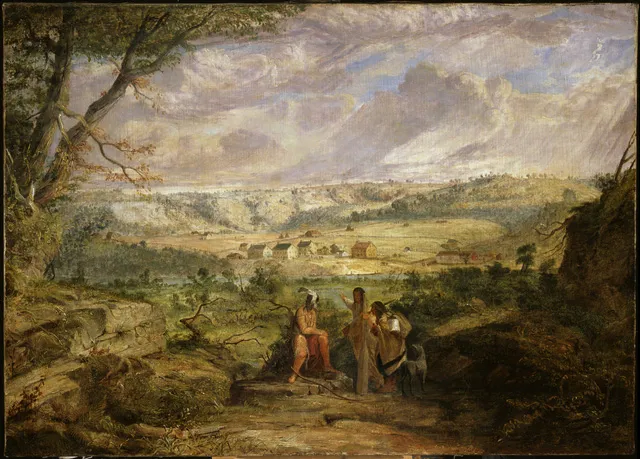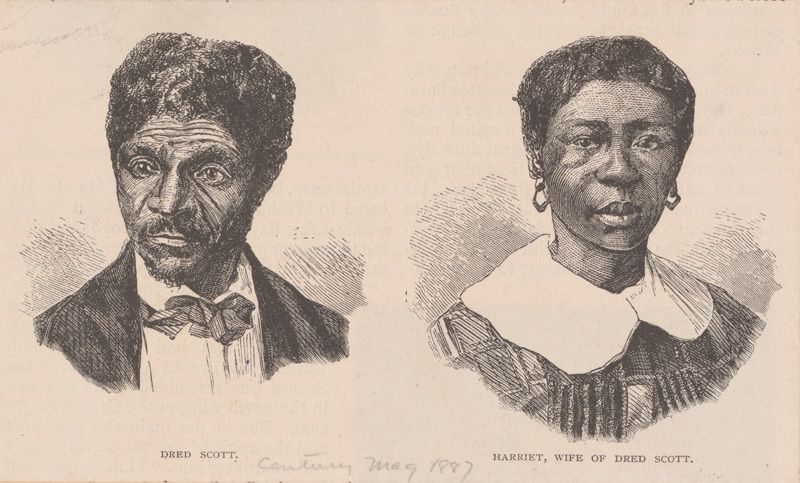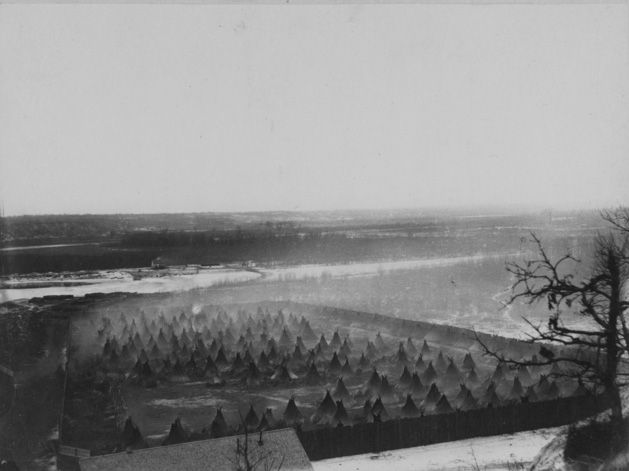NATIONAL MUSEUM OF AMERICAN HISTORY
Where Black and Indigenous History Come Together
Minnesota doesn’t typically come to mind when you think about slavery and the Civil War.
:focal(400x276:401x277)/https://tf-cmsv2-smithsonianmag-media.s3.amazonaws.com/filer_public/63/c0/63c02bf8-b7c9-4b6a-9422-20b497035eb3/sioux_village.jpg)
Minnesota doesn’t typically come to mind when you think about slavery and the Civil War. It’s also not a place that’s figured into the national imagination when it comes to Black activism, either—at least, not until recently. However, as part of the series on “Black Life in Two Pandemics,” this post draws on several events in Minnesota’s history to help us understand the connections between the historic and the current experiences of Black and Native people in the Midwest. And yes, you’d expect a historian to claim that this history matters, but it’s crucial that we understand why it’s important. These encounters matter because they demonstrate the long history of Black and Native people in what’s now the state of Minnesota, and these encounters underscore and explain critical moments in the nation’s history.
There are a number of events I could have included here, such as the establishment of 16 American Indian boarding schools across the state in the late 1800s and early 1900s, or the 1920 lynchings of three Black circus workers in Duluth in the wake of what’s come to be called the “Red Summer.” I could have explained how National Guard troops were deployed in Minneapolis in 1967 when racial tensions in the city led to protests and demonstrations, or how American Indians in Minneapolis formed the American Indian Movement in 1968 to protest police brutality. Instead, I’ve chosen to center this essay around Fort Snelling, particularly in terms of its construction as a military outpost, the experiences of enslaved people at the fort, its role in the wake of the 1862 U.S.-Dakota War, and its use as a headquarters for buffalo soldiers. Fort Snelling stands as a symbol of expansion and exploitation, but it also underscores the intertwined histories of Black and Native people in what’s now Minnesota. The history of the fort is one of white supremacy that shapes both Minnesota and national law and history, and it helps us understand the interconnected histories of racist violence, especially during this dual pandemic of police violence and COVID-19.
Early Encounters
The Dakota people who have called this land home for centuries have a sacred place they call Bdote, which means “where two waters come together.” Bdote is where the Minnesota River (Mni Sota Wakpa) meets the Mississippi River (Wakpa Taŋka), and it’s what many Dakota consider to be their place of creation. Those who lived near Bdote tended to move with the seasons in order to find food and resources for their communities. European explorers, traders, and missionaries reached the Dakota by the mid-1600s. Intermarriage among Europeans, Black people, and Native people led to multifaceted kinship connections. George Bonga (1802–1880), who became a fur trader with the American Fur Company and later served as a guide and interpreter for government agents, was descended from enslaved people on his father’s side and Ojibwe people on his mother’s side.
The Louisiana Purchase, signed a year after George Bonga’s birth, included Native lands. In 1805 U.S. Army Lieutenant Zebulon Pike set out to find places to build military posts. Pike encouraged Native leaders to sign the Treaty of St. Peters, also known as “Pike’s Purchase.” The treaty allowed the United States to build military posts and promised that the Dakota could use the land as they always had. Pike also promised to pay the Dakota for their land, but he left the amount blank. According to historian Roy Meyers, the Dakota received “$200 worth of presents” on the spot, and the Senate filled it in when they ratified the treaty.

Construction on the fort began in 1820. The U.S. government had several reasons for wanting to build a fort near Bdote. According to historian Peter DeCarlo, the United States wanted to keep the British out, profit off the resources in the region, and stay on top of the fur trade. The government also wanted to try to keep the peace between the Dakota and their Ojibwe neighbors in order to draw more Euro-American settlers to the region. Military officers, government officials, and fur traders were among those who would spend part of their lives at Fort Snelling. However, these men forcibly brought other people to the fort. The experiences of enslaved people at Fort Snelling intersected with both the growing Euro-American population and the Native peoples who found themselves on the edges of their own lands.
Slavery, Freedom, and the Supreme Court
While the Civil War wouldn’t start until 1861, several pieces of legislation brought arguments over slavery home to Fort Snelling. The 1787 Northwest Ordinance outlawed slavery in the Northwest Territory, and the Missouri Compromise of 1820 also banned slavery in the Louisiana Purchase north of the 36°30’ parallel. However, officers in the U.S. Army were among those who illegally brought enslaved people to Fort Snelling. Lawrence Taliaferro, who served as the Indian Agent at the fort from 1820 to 1839, was the biggest local slaveholder in the region. He also imported enslaved people from Virginia to hire them out or sell them. According to historian Walt Bachman, the only thing Taliaferro lacked was an auction block. Colonel Josiah Snelling, the fort’s namesake who oversaw its construction, also owned enslaved people.
While the names of many enslaved people who were brought to Fort Snelling were never written down, enslaved people at the fort resisted their condition in numerous ways, including four who sued for their freedom. Elias T. Langham, the subagent at the Indian Agency, bought a woman named Rachel in 1830 for Lieutenant Thomas Stockton. Rachel was enslaved at Fort Snelling and at Fort Crawford in what would become Wisconsin. Rachel sued for her freedom in Missouri, and the state Supreme Court ruled in her favor in 1836. Fur trader Alexis Bailly bought an enslaved woman named Courtney in 1831. Her son, Joseph Godfrey, is the only person who is known to have grown up as an enslaved person in what is now Minnesota. Courtney also sued for her freedom, and she was freed after the decision in Rachel’s case.
Two others would become famous for their resistance to enslavement. While it is not clear if Lawrence Taliaferro bought or inherited an enslaved woman named Harriet Robinson, he brought her to Fort Snelling around 1835. Dr. John Emerson, a U.S. Army surgeon, came to Fort Snelling the following year and brought with him an enslaved man named Dred Scott. Scott and Robinson were married in either 1836 or 1837, and Taliaferro either gave or sold Robinson to Emerson. Emerson took the Scotts to St. Louis in the early 1840s, and they sued for their freedom in Missouri in 1846 and 1847. Their case eventually made it to the Supreme Court. In the 1857 decision in Scott v. Sandford, Chief Justice Roger B. Taney argued that enslaved people were not included—and were not intended to be included—under the word “citizens” in the Constitution. Instead, he wrote, they were “considered as a subordinate and inferior class of beings…[who] had no rights or privileges but such as those who held the power and the government might choose to grant them.” Taney also compared enslaved people to American Indians, arguing that the situation of enslaved people was “altogether unlike that of the Indian race.” Even though Native nations “were uncivilized, they were yet a free and independent people…governed by their own laws.” Taney’s decision would have a lasting effect on American history—and particularly on Black and Native history.

Wars within a War: The Civil War and the U.S.-Dakota War
Fort Snelling was temporarily decommissioned in 1858, the same year Minnesota became a state. The Civil War started in 1861, four years after the Dred Scott decision, and the government brought Fort Snelling back into service that same year to train newly recruited soldiers for the Union. In 1862 war broke out in Minnesota. Known as the U.S.-Dakota War, the four-month conflict was, in short, the result of treaty violations by the federal government and the negligence of Indian agents. We tend to think of the Indian Wars as something confined to the American West, but the U.S.-Dakota War highlights the mid-1800s contestations over lands and resources. The Dakota, like other Native nations across the country, had been interacting with Europeans and Euro-Americans for centuries. They had tried different strategies of cooperation, negotiation, and outright resistance to government interference, military operations, religious imposition, and growing settlement. When that didn’t work, some argued that they should go to war.
It’s important to recognize that what happened in Minnesota did not just occur spontaneously. Decades of ever-increasing settlement by Europeans and Euro-Americans led to continued conflicts with Native people in the state. The Ojibwe and the Dakota were forced to sign treaties (most notably in 1837 and 1851) that ceded hundreds of thousands of acres of their lands. Missionaries and the federal government also worked to assimilate American Indians. They wanted Native nations to give up their languages, their cultures, their religions, their political systems, and their ways of life in order to become what non-Natives considered “civilized.” The push for assimilation also divided Native communities: some believed that assimilation was the best thing to do, others wanted to continue living their traditional ways, and still more Dakota tried to incorporate some new practices into their traditional systems.
The treaties the federal government signed with Native nations like the Dakota promised payments, goods, and resources (usually called annuities) in exchange for their lands. In the midst of the Civil War, though, keeping their treaty obligations wasn’t high on the government’s list of priorities. Treaties between the federal government and the Dakota had outlined how the government would provide food and goods for the Dakota in order to stop the Dakota from continuing their traditional hunting and gathering practices. When the government stopped providing these resources, it meant that many Dakota were hungry. They couldn’t hunt or harvest like before, and there weren’t enough resources to go around. If they were able to get any provisions, the food was often spoiled or unfit for consumption. By the summer of 1862, with no annuities in sight and traders unwilling to extend credit, the Dakota had nowhere to go and no one to turn to. Trader Andrew Myrick told the Dakota that, if they were hungry, they could “eat grass.” In August 1862, a group of young Dakota men skirmished with some settlers near Acton, killing five of them. The Dakota leader, Taoyateduta (also known as Little Crow), reluctantly agreed with the faction of the Dakota who argued for continuing the attacks in hopes of driving out the settlers. “We have waited a long time,” Taoyateduta told Indian agent Thomas J. Galbraith. “The money is ours, but we cannot get it. We have no food, but here are these stores, filled with food. …When men are hungry they help themselves.”
The fighting raged through southern Minnesota for several months, and there were many divisions among the Dakota as the war continued. When the fighting ended, some Dakota moved north and west to escape the army. Many Dakota who had not taken part in the fighting met General Sibley at a place that came to be known as Camp Release, and Sibley took all the Dakota into military custody. A military commission sentenced more than 300 Dakota men to death, and the remaining Dakota were forced to march to Fort Snelling. More than 1,600 Dakota reached Fort Snelling in November 1862, and they were imprisoned there for the rest of the winter. On the day after Christmas, 38 of the Dakota men who had been sentenced by the military commission were simultaneously hanged in Mankato. It was the largest mass execution in the history of the United States, and President Abraham Lincoln signed off on the executions a few weeks before he issued the Emancipation Proclamation.
The men whose sentences had been commuted were forcibly removed to Fort McClellan in Davenport, Iowa, far away from their families imprisoned at Fort Snelling. The Department of the Interior and the U.S. Army argued over who was responsible for the Dakota at Fort Snelling. The Dakota didn’t have adequate food, clothing, shelter, or access to medical attention, and several hundred Dakota died during the winter. Those who survived were forced to move to Crow Creek, a barren reservation in South Dakota, the following spring. Throughout 1863 and 1864, as the Civil War continued to rage across the South and the West, the U.S. Army launched punitive expeditions into Dakota Territory. Fort Snelling became the epicenter of these efforts, serving both as a military outpost and as a prison for captured Dakotas. The effects of the government’s subsequent treatment of the Dakota linger more than 150 years later. Dred and Harriet Scott’s enslavement at Fort Snelling, Taney’s ruling, the outbreak of the Civil War, and the U.S.-Dakota War have had lasting consequences in Minnesota and across the country.

Less than 20 years later, the U.S. Army used Fort Snelling as the regimental headquarters for several segregated all-Black units who became known as “buffalo soldiers.” Congress passed the Army Reorganization Act in 1866, and buffalo soldiers were tasked with, among other things, helping control American Indians on the Great Plains and in the American West. No one is quite sure how they got their name, but the buffalo soldiers took part in nearly 200 conflicts, skirmishes, and battles during the era of the Indian Wars. Their legacy is complicated, particularly in terms of reconciling pride in military service with the regiments’ role in the violence against and displacement of Native people.
The Legacy of Fort Snelling
The site of Fort Snelling had been chosen for its importance as a military outpost, and it now sits in the major metropolitan area known as the Twin Cities. Saint Paul, the state capital, was incorporated in 1854, and the neighboring city of Minneapolis was incorporated in 1867. Fort Snelling was decommissioned in 1946. It was designated as a National Historic Landmark in 1960, and it reopened as Historic Fort Snelling in 1970. Its initial interpretations centered on life at the fort in 1827, so visitors never learned about enslaved people, the U.S.-Dakota War and its aftermath, or buffalo soldiers. However, local Black and Native community members, activists, and organizations have encouraged the Minnesota Historical Society (MNHS) to offer more inclusive and comprehensive interpretations and programming. In 2019, for instance, MNHS updated some signage to read “Historic Fort Snelling at Bdote.” Continued activism has helped lead to a plan to revitalize the fort and increase the number of stories that will be told, including perspectives from Native nations, soldiers, enslaved and free African Americans, and Japanese Americans during World War II. Despite these changes, the historical presence of enslaved people at Fort Snelling and the military’s decision to imprison Dakota families at the fort after the U.S.-Dakota War—two methods of policing and criminalizing Black and Native people—reverberate into the present, highlighting the prevalence of police brutality against Black and Native bodies in Minnesota and across the country.
Katrina Phillips is an enrolled citizen of the Red Cliff Band of Lake Superior Ojibwe.
This post was originally published on the National Museum of American History's blog on August 26, 2020. Read the original version here.
